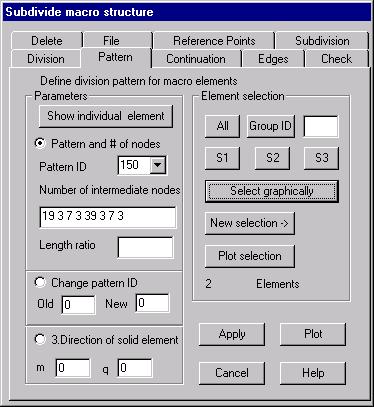Pattern: Specify subdivision data for
individual macro elements
This command is used to assign special
transition patterns to individual elements or to specify subdivision data for
the direction perpendicular to the bottom surface of solid elements.
Button „Apply“ assigns current settings to
selected elements.
Following dialog shows the available options:

Show
individual element
Clicking
this button, one individual element can be selected graphically. The assigned
subdivision parameters of the selected element are immediately shown in the
dialog and may be changed and newly assigned by pressing “Apply”.
Pattern and
number of nodes
This
option has to be selected if a pattern and subdivision data for individual
elements should be assigned.
Pattern ID:
The pattern ID must be given. Available patterns are shown in the following
chapter and can be selected out of a list box (not all available pattern IDs
are shown in the list box). If you don’t specify an ID, currently defined IDs
for the elements remain.
Number of intermediate nodes: Give the number of intermediate nodes for the
edges of the bottom surface of the element in counter clockwise order. With
elements of type 150 or 400 the ratio of largest to smallest FE edge length
should not be greater than 4.
Length ratio: For some pattern it’s possible to specify the ratio between the last
and first segment length for directions 1 and 2.
Change
pattern ID
Using
this option the assigned pattern ID may be changed for the selected elements
without changing the number of intermediate nodes for the edges of the
elements. The old ID and the new ID must be given. For example the ID 142 may
be changed to ID 150.
3.
Direction of solid elements
This
option has to be used if the subdivision data for the 3. direction of solid
elements should be assigned. For parameter m the number of intermediate nodes
must be given, optionally also the ratio between the last and first segment
length ( parameter q ) can be given.
Element
selection
Select
elements the pattern should be assigned to.